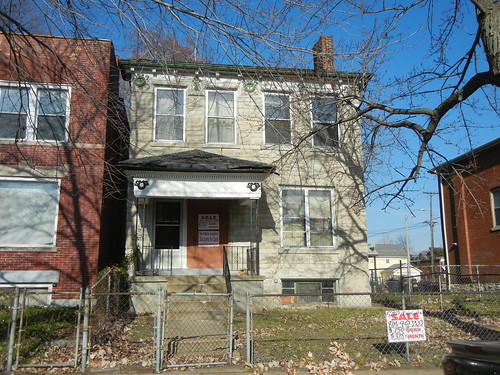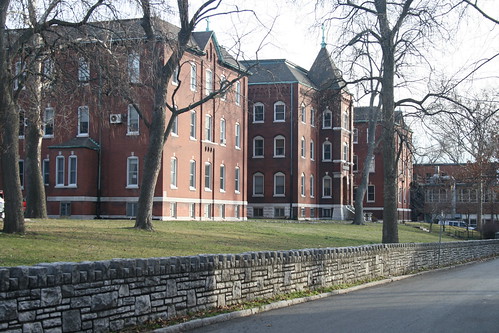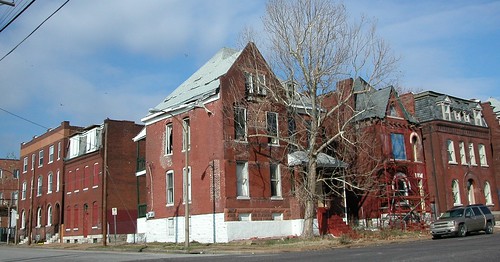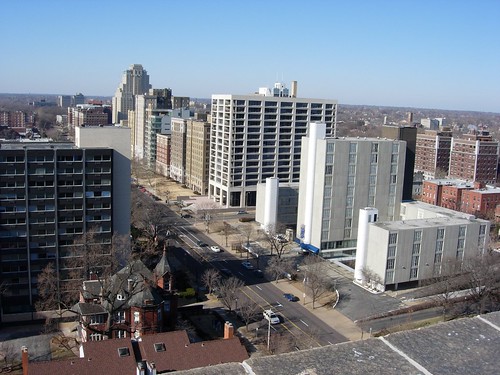by Michael R. Allen
Currently we are working on preparing a historic tax credit application for a property on the 5200 block of Kensington Avenue. The block is located behind the mighty, proud building housing Soldan High School, and slopes downward into one of the city’s hidden gem neighborhoods, Academy. Most of the Academy neighborhood is listed in the National Register of Historic Places as the Mt. Cabanne-Raymond Place Historic District (nomination by Lynn Josse). The streets in the area are lined with a classic array of St. Louis brick (and a few stone) houses and two-flats, sporting the latest fashions in architecture at the turn of the twentieth century.
However, vacancy is a problem. Vacant lots dot a still very cohesive landscape, but vacant houses may start to dominate. On our first day of work, we spotted a hand-written for-sale sign in front of a vacant house across the street.

by Michael R. Allen

The impending closure of Catholic girls’ school St. Elizabeth Academy revisits territory hotly debated in Tower Grove East two years ago, when the Academy threatened to demolish parts of its historic campus to make itself more marketable. The Board of Directors of St. Elizabeth Academy and its tireless, persistent President, Sister Susan Borgel, were facing the reality that the very existence of the 131-year-old institution was threatened. A possible counteract was to demolish all of the buildings on the campus save a 1957 wing on Arsenal Street, and build contemporary facilities that other Catholic schools like Nerinx Hall and Rosati-Kain were able to provide. After careful consideration, the Tower Grove East Neighborhood Association formally opposed the demolition, but also pledged to assist the Academy’s efforts to sustain itself should preservation of its historic buildings be part of the plan. The crux of historic preservation again surfaced: do we first preserve buildings or communities of people that support buildings? Should cultural resource laws protecting buildings be bent when historic institutions’ futures are on the line?
The building known as “Powell Square,” located at Third and Cedar streets near downtown, was built in 1917 as the pharmaceutical factory of the John T. Milliken Chemical Company. Later users included the Fulton Bag Company and Dan Powell Company, which both used the building for warehouse space. A company controlled by attorney Stephen Murphy has owned the building since 2001. Murphy, who owns neighboring buildings in the south riverfront area, planned to rehabilitate the building into artists’ studios and other uses, but eventually abandoned the project.
On December 28, 2012, the Building Commissioner Frank Oswald approved a permit to demolish the building as an emergency order. The City of St. Louis is paying for the demolition, which will be billed to the owner. We asked local entrepreneur Ryan Albritton to discuss the demolition and what it means to the city.
This video documents a site visit on January 6, 2013. What a beautiful day for a walk in the forest!
More information can be found on the Laumeier Sculpture Park website.
On Christmas Eve, we visited a hallowed site in our city’s architectural heritage: the James Clemens, Jr. House. The condition of the house and its still-evident beauty moved Steven Fitzpatrick Smith, who joined us for the visit. As the video shows, the condition of the Clemens House continues to worsen. Yet we cannot let this treasure be lost.
by Michael R. Allen

On November 19, the Building Division issued a demolition permit for the historic house at the northwest corner of Soulard Avenue and Tucker Boulevard on Bohemian Hill. The Building Division paid over $7,000 for the demolition as part of routine city demolition package for condemned buildings. This house was condemned for demolition in August 2007 and its owners were AWOL. Yet the house was likely to go to Sheriff’s land tax auction in 2013, and could have been purchased by a rehabber for less than $2,000.
by Michael R. Allen

On June 22, 2009, the Preservation Board voted 3-2 to grant preliminary approval to demolition of a landmark work of non-residential modern architecture designed by a renowned architect with a national practice, located in the Central West End Local Historic District. Readers with memories long and short will know that this building was the DeVille Motor Hotel (later San Luis Apartments) at the northeast corner of Lindell and Taylor avenues, completed in 1963 and designed by Charles Colbert, partner in the firm of Colbert Hess Lowery & Boudreaux. Some of the same number will know the arduous struggle by preservationists to get the Archdiocese to reconsider demolishing the curvaceous former motel, which ended up in a lengthy Preservation Board meeting.
Preservation Research Office is pleased to present the first episode of a regular video series called This Building Matters. The premise is simple: Preservation is something lots of of people care about and practice in their daily lives. This series documents the everyday experiences of historic preservation in St. Louis, and the preservationists in our communities across the region. The format is simple and spontaneous — these episodes come from our field work, and may be unrehearsed. After all, we run into people doing good work every day.
For our first effort, we talked to Stefene Russell about two historic houses on her block in Old North St. Louis. Stefene lives across the street and is rehabbing a small house that, along with the two houses shown here, is one of the three remaining buildings on the south side of the 1900 block of Palm Street. Their loss would change the lives of Stefene and her neighbors forever. [Note: Turn up the volume; our audio skills are young.]
If you have an idea for the series, let us know by posting a comment or sending Michael Allen a note at michael@preservationresearch.com. Thanks for watching!


